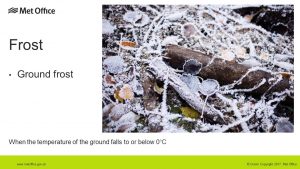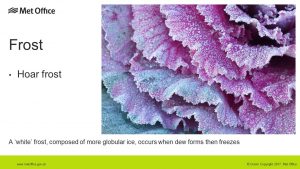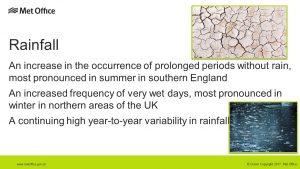A flowerbed in Town Hall Place
This isn’t the work of one of our members, but it shows that even a modest “garden” can be lovely. I tried to ask the owner if it was OK to post it on our website, but there was no reply to my knock.
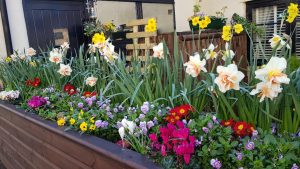

A flowerbed in Town Hall Place
This isn’t the work of one of our members, but it shows that even a modest “garden” can be lovely. I tried to ask the owner if it was OK to post it on our website, but there was no reply to my knock.

Gavin Haig’s talk last night (12th October) was both entertaining and educational, and we are very grateful to him for coming from Tiverton to talk to us. Unfortunately there was not enough light in the hall for me to make notes, so I’m afraid this is the only record of the evening. However he did invite us to make a Club trip to Tiverton to see the hospital healing garden and as we haven’t had a Club trip for a while that would probably be very popular.
Life is just a Bed of Roses (though perhaps not at the moment)
Photos below from rose-grower Roger Hottot.
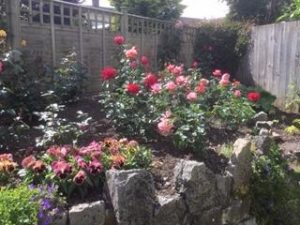
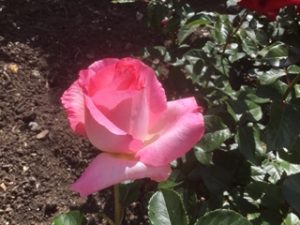
Roger has been winning the rose classes in the Bovey Tracey Garden Club Summer Show for many years.
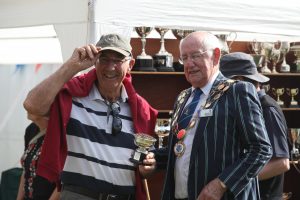
Roger receiving the Sir Ben Smith Rose Bowl for his rose entries in 2019.
If anyone knows anything about Sir Ben, we’d like to hear about him.
The evening began with the Chairman appealing for donation of cakes for the Spring Show, for two boilermen for the Summer Show, and for contributions for the Club website.
Robin Hill then took over and gave us a very enjoyable talk on the changes over the years to the garden in Belstone, near Oakhampton, which his parents came to from Hertfordshire in 1967. It turned out that many of her members had been to Andrew’s Corner.
Gardening at an altitude of around 1,000 feet is challenging and Robin’s policy is very much to find the right plants for the conditions.
In 1972 you would have found lots of dwarf conifers and heathers in the garden, but heathers like an open situation and as the conifers grew they created shade, so the heathers stopped thriving and were replaced.
The Hill family, Robin, Edwina and their children, moved to Andrew’s Corner in 1979 and a few years later borrowed some of their neighbour’s land for their veg garden and for grazing for their goats.
A storm in 1990 brought down 20 of their trees along with the steeple of nearby St. John the Baptist Church, Hatherleigh. Another extreme weather event occurred in the winter of 2010/11, when there was heavy snow and temperatures of below 15 deg C.
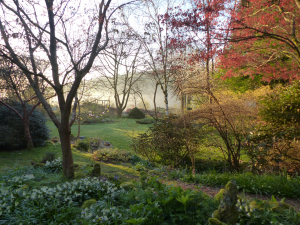
The garden in April
Andrew’s corner is normally open to the public in February for snowdrop viewing – they have over 100 varieties. An early herald of spring is also the winter aconites such as Eranthis hyemalis.
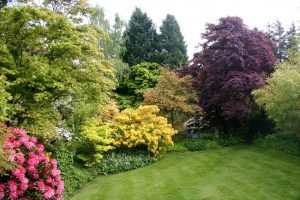
And again in May
Robin showed us a huge selection of the plants he grows, many of which prefer acid soil. (Sadly, my garden has slightly alkaline soil.) He has a particular love of acers and particularly recommends erythronium such as the lovely “White Beauty” below.
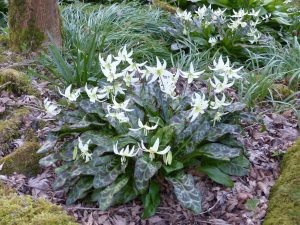
Erythronium White Beauty
The ones I particularly liked were: Carolina spice (Calycanthus floridus), the Chilean Fire Bush (Embothreum coccineum) and the Scottish Flame Bush (Tropaeolum speciosum).
If you’d like to learn more about this interesting garden, or to visit it, you can find Robin’s website at Andrew’s Corner.
Tuesday 14th January was a miserable day – wet and windy – and I wondered how many members would brave the elements to attend David Ramsden’s talk on The Barn Owl Trust. David is Head of Conservation and the Founder of the Trust, which is based in Waterleat, Ashburton. It was therefore a lovely surprise to find an almost full house and to see so many unfamiliar, as well as familiar, faces.
David started the evening off by playing the calls of three of our native owls – the little owl, the tawny owl and the barn owl.
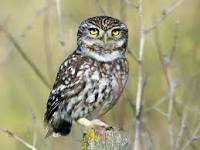
little owl
Little owls are very rare in the south-west, probably because farming methods mean that beetles, their favourite prey, are in short supply. They are most likely to be spotted in mid-Devon where the habitat is mixed.
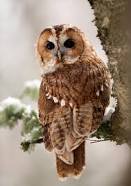
tawny owl
The tawny owl is the commonest owl in the UK (we hear them almost every night in Bradley Road). They are woodland birds, highly territorial and can be found where there are big trees.

the “moon” face of the barn owl
Sadly, barn owls have greatly decreased in number in recent years. Less nocturnal than tawny owls, the barn owl hunts by sound – its distinctive face shape funnels sound into its ears.
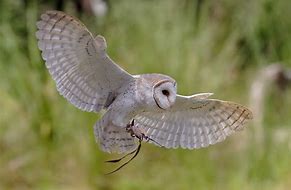
Barn owl in flight
Its fight is silent and barn owls have a “memory map” which allows it to find its way around in the dark. Its home range (of about 1,250 acres) is enormous compared with the territory of the tawny (around 50 acres).
Barn owls are lowland birds and are unlikely to be found on Dartmoor. They eat mice, voles, shrews and small rats and don’t put on weight, no matter how much they eat. This can be a problem in severe winters as they can lose weight. The female lays an average of 5 eggs and incubation takes 31 days. The young fly after around 3 months and the average success rate is 2.5. Two clutches can be produced each year. All the above numbers are highly variable, depending on food supply and weather.
The young disperse between August and November and typically only one in four survives into adulthood. Owls which survive their first year of life live for an average of four years; the UK record is 15 years.
The decline in numbers is the result of modern farming techniques, changes in farm buildings, the use of rat poison by farmers, which kills the rats (also mice, voles and hedgehogs) but also anything which eats the carcass.
David asked us to report any sightings of barn owls to the Trust. Their email address is www.barnowlssurvey.org.uk
I happen to be rather keen on owls, so bear with me while I show you a couple of my photos:
Verreaux’s is a large African owl, common in acacia and riverine woodland.This photo was taken on Lake Baringo in Kenya. I have posted a large photo in the hope you can see the lovely pink eyelids.
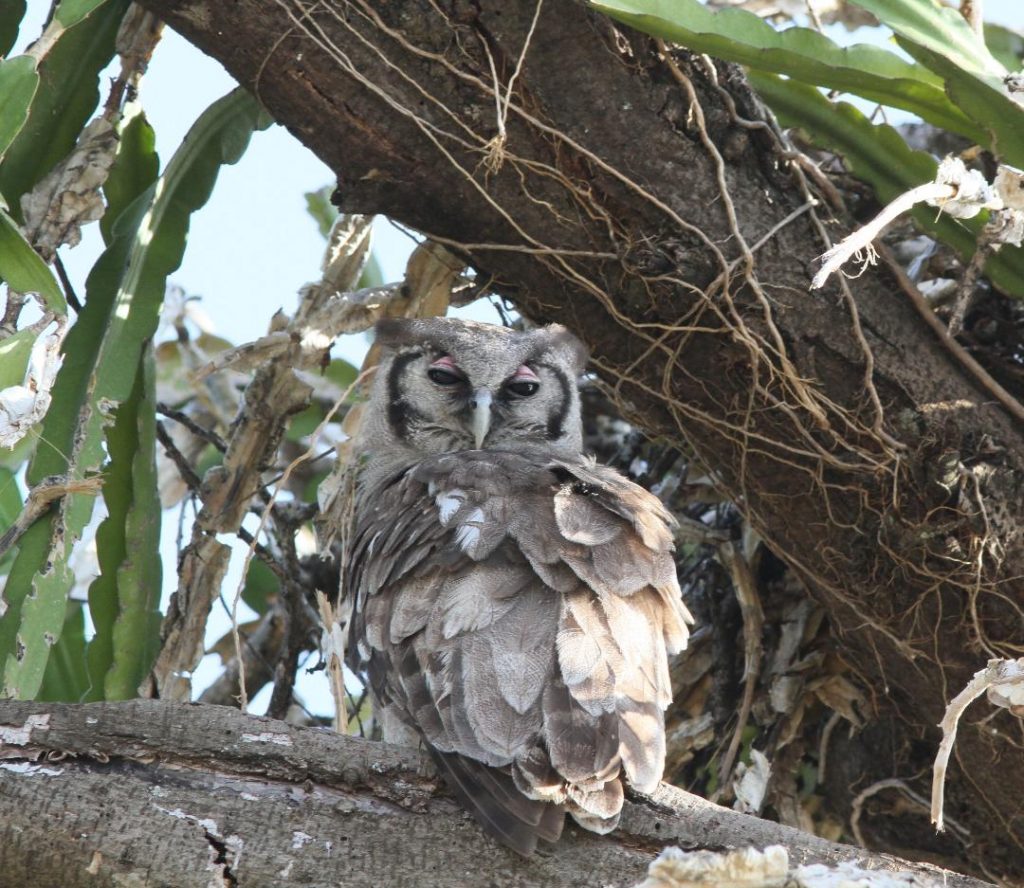
Verreaux’s Eagle Ow
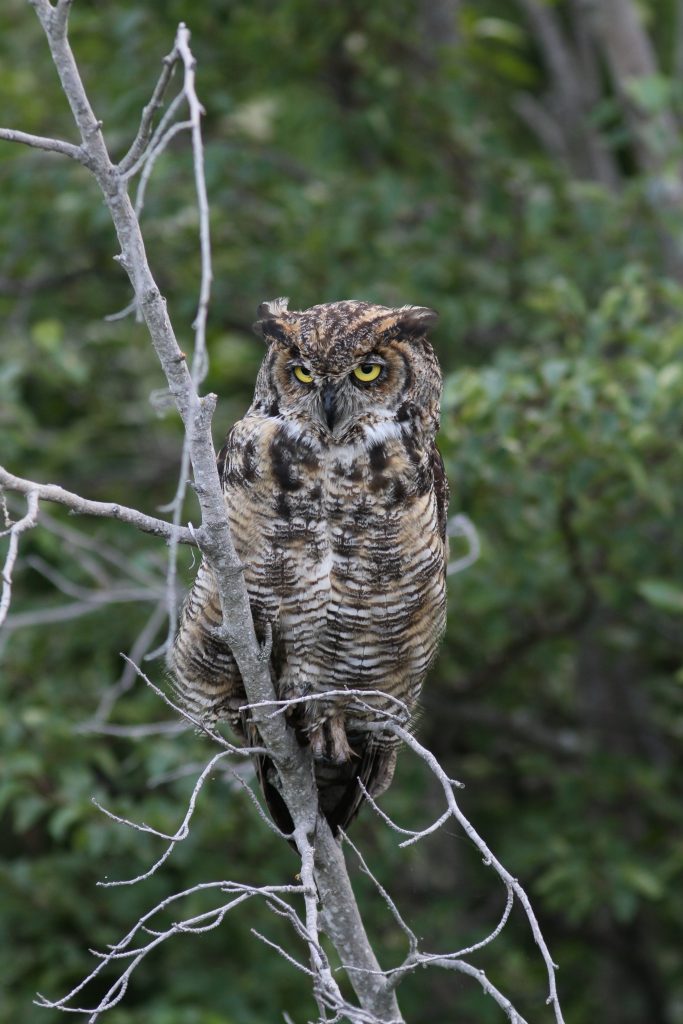 And this beauty is a Great Horned Owl, which posed for us for almost an hour in central Alaska
And this beauty is a Great Horned Owl, which posed for us for almost an hour in central Alaska
We had a truly delightful talk on December 10th from David Usher, who knows the Gardens intimately having spent 21 years working there, latterly as Head Gardener.
The House and Gardens, located at Cheddon Fitzpaine near Taunton, are best known as a collaboration between garden designer Gertrude Jekyll and architect Sir Edwards Lutyens but offer more – 300 years of history to explore and enjoy.
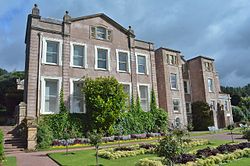
Hestercombe House
To reach the property exit the M5 at Junction 25 and Hestercombe is only 5 miles from the junction – follow the brown signs. David suggested you stop at the Taunton Services and pick up a Hestercombe brochure which gives a discount on the entrance charges. As far as I can see from their website, the full adult entrance charge is £13.30.
From 1391 until 1872 Hestercombe was owned by the Warres family and in 1731 John Bampfylde, MP for Exeter, who had married the daughter of Sir Francis Warre, commissioned plans for a garden. Coplestone Warre Bampfylde designed the Landscape Garden as we see it today, having inherited the estate in 1750.
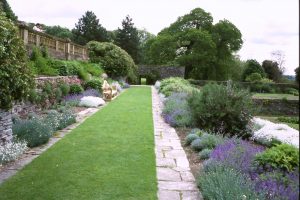
Below the Terrace
The last of the Warre family died in 1872 and Hestercombe was acquired by the 1st Viscount Portman who remodelled the house and created the Victorian Terrace and fountain. In 1903 his grandson commissioned Sir Edward Lutyens to create a new formal garden and Gertrude Jekyll designed the planting scheme.
World War I saw many Hestercombe staff in action and in WW II the house and estate housed the read HQ of the British Army 8th Corps. Six barrack blocks were built.
After the death of Mrs Portman in 1951, the administration of the estate was taken over by the Crown Estate Commissioners. Various possible tenants were considered and in 1955 the Somerset Fire Brigade relocated its HQ from Taunton to Hestercombe. Ultimately the Fire Brigade found that too much money was required to run the estate and now it is run by the Hestercombe Gardens Trust.
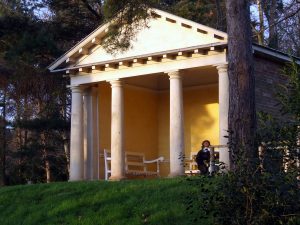
The Temple Arbour
When David joined Hestercombe in 1983 the Landscape Garden had become overgrown and was difficult to access and John Bampfylde, David and Philip White of the Somerset Wildlife Trust (and now chief executive of the Hestercombe Gardens Trust) won a grant to restore it. Excess wood was cleared out and the pond dredged of its mud – a 10 acre field was covered to a depth of 6 to 8 inches by the mud removed.
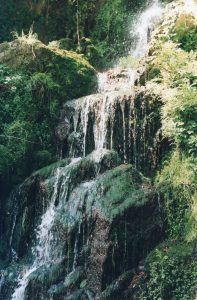
The Cascade
Today there are a number of classical and rustic buildings in the Landscape Garden, including the Temple, the Witches of Hestercombe Cabin, the Mausoleum, the Gothic Alcove and the Cascade.
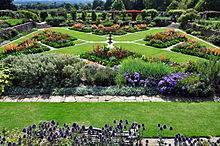
Perhaps the highlight for many people will be the Edwardian Garden designed by Lutyens and planted by Jekyll.
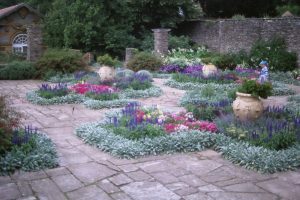
Brian Carlson had taken a lot of trouble to prepare an excellent talk which was greatly enjoyed by the large number of members present. Our thanks to him.
Pelargoniums are tender plants originally brought to England in the 1600s by sailors returning from the Cape. They were sold for huge amounts of money by the sailors, who presumably then had no need to return to sea!
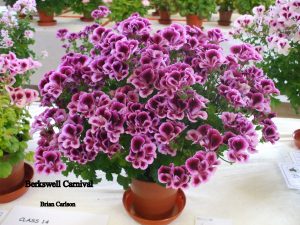
An angel Pelargonium
At that time they were called “Geranium” which are hardy, herbaceous plants. French botanists realised that being tender they were not the same plant as Geraniums and renamed them Pelargoniums or “stork’s bill” from the shape of the seed pod.
Pelargoniums are usually grown in a pot, or as bedding. Brian recommended compost comprising 3 parts good quality multi-purpose compost to 1 part sharp sand or horticultural grit. Add slow release fertiliser according to the maker’s instructions.
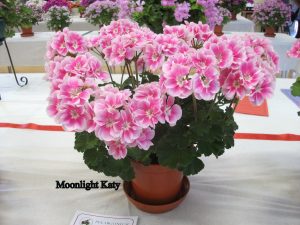
A basic zonal Pelargonium
He demonstrated taking cuttings (you can do this from August onwards) and showed us a novel way to arrange them. Choose the pot you wish to use, then place another, smaller inside the first pot. Fill both pots with your compost. Now take out and empty the smaller pot and place your cuttings around the edge of the larger pot (as recommended by Monty Don).
This means that when you think they should have rooted you can simply remove the inner pot to find out. What an excellent and simple idea!
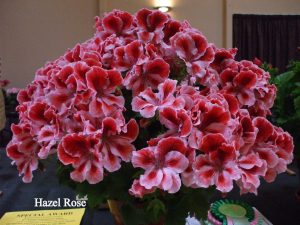
A regal Pelargonium
Brian also recommended the use of Jiffy pots as an alternative to the above. Which ever method you use, hormone rooting powder is of little use as the hormone degrades after 6 months. (I suppose a way round that if you are keen on rooting powder is to buy a pot and share the contents with your fellow gardeners, so that you use it within 6 months.
Over the winter, Brian uses a high nitrogen fertiliser then he changes to a balanced product in March then a high potash one, such as Tomorite, in April. He suggested Rose Clear Ultra and Bayer Fungus Fighter, as an insecticide and fungicide respectively.
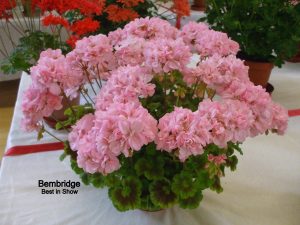
A dwarf Pelagonium
Miniature Pelargoniums are grown in small pots and have not more than 5 inches to the top of the leaves, with flowers above. (I bought Bold Cherub from him, so you may see that in the Show – class 93 for those of you who bought plants from Brian.)
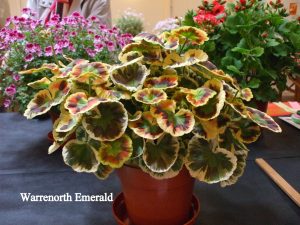
A tricolour Pelargonium
Zonal Pelargoniums are so called because of the dark coloured area in the centre of the leaf. They are classified as basic, dwarf, miniature, stellar etc. There are also fancy leaf zonal varieties with their leaves being bicolour or tricolour for example. I must say I loved the gold tricolour Warrenorth Emerald Brian showed us, which is essentially a foliage plant.
We don’t have a foliage class in the Show – do you think we should include one? Please let me know if you do.
We were very grateful to Peter Burks, garden centre manager, Fermoy’s garden centre, for agreeing to talk to us, at quite short notice, when our booked speaker pulled out. It turned out to be a very enjoyable evening.
Peter Burks has a degree in horticulture and worked in garden centres around the south-west before accepting his present position with Fermoy’s. He brought with him a large number of plants, all with winter interest of some kind, either flowers, leaf colour or bark colour.
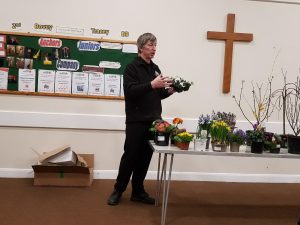 He started his talk with winter-flowering pansies. These familiar plants are hardy, flower reliably and are long-lasting. For best results, buy them in flower in late autumn or early winter and place in a sunny position.
He started his talk with winter-flowering pansies. These familiar plants are hardy, flower reliably and are long-lasting. For best results, buy them in flower in late autumn or early winter and place in a sunny position.
Next chronologically are hardy cyclamen (not to be confused with winter-flowering cyclamen sold as house plants). Cyclamen do well under trees (provided the site is not too dry) and bring winter cheer to gardens and containers.
Peter brought some lovely primulas (I bought a Primula Belarina from him, which you will see if you pass my front door). There is a huge variety of these plants, with single, semi-double and double flowers. Remember to deadhead these.
Peter asked what the difference between a primula and a polyanthus is and one of our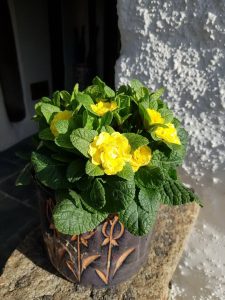 expert members correctly pointed out that polyanthus has a single strong stem bearing a cluster of flowers, while primulas have many short stems, each with a single flower.
expert members correctly pointed out that polyanthus has a single strong stem bearing a cluster of flowers, while primulas have many short stems, each with a single flower.
Snowdrops should be bought in a pot in early September. Plant them immediately and don’t let them dry out.
All the above-mentioned plants will reflower year after year, except that pansies are usually replaced.
Peter then turned to bulbs. Hyacinths and daffodils are hardy and reliable and prefer a reasonably sunny position. Dividing them when they form clumps will reward you with an improved display. Please remember to enter your daffodils in our Spring Show!
Campanula are flowering earlier nowadays, probably due to climate change. Hebe pascal has lovely purple foliage in winter and is suitable for a pot. Just clip with shears after flowering to keep it the size you want.
Erysimum (wallflower) will flower all year in a sunny position. They are short-lived, so take cuttings.
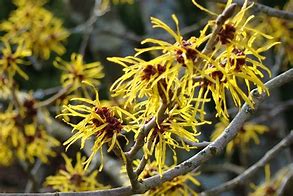 Hamamelis or witch hazel prefers a slightly acidic soil. They have fragrant blooms and autumn colour. The RHS suggests growing them behind Sarcococca (Chrismas box) which also has a lovely scent. Look for small plantlets under your Christmas box. (I’ve just been to look under mine, and yes, there were some little plants – will pot them up and see what happens.)
Hamamelis or witch hazel prefers a slightly acidic soil. They have fragrant blooms and autumn colour. The RHS suggests growing them behind Sarcococca (Chrismas box) which also has a lovely scent. Look for small plantlets under your Christmas box. (I’ve just been to look under mine, and yes, there were some little plants – will pot them up and see what happens.)
Cut cornus (dogwood) down hard in March for lovely coloured stems (and perhaps use your cuttings for propagation). Camelias such as Sasanqua Yule Tide have a long flowering season, but need acidic soil.
Grevillea has exotic looking flowers from October to March and likes a sunny position.
The hardy viburnum gives a good show of flowers, though I notice it has been greatly over-used by whoever planted up the gardens of the new Bovis development at Bradley Bends.
Escallonia glowing embers and Choisya sundance both have lovely yellow leaves and need sun to maintain the leaf colour. Lonicera fragrantissima has fragrant winter flowers and also benefits from full sun. Abelia is another shrub which likes full sun, and while summer flowering, retains the bracts over the winter.
There are many varieties of hellibores, but plant them where they will not dry out.
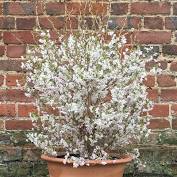
Prunus kojo-no-mai is a small, very hardy cherry blossom which is ideal for a pot. Grow in half or full sun.
 Thuja rhinegold is a pyramid-shaped conifer with an attractive rusty-red colour. It is suitable for a container, rockery or small border.
Thuja rhinegold is a pyramid-shaped conifer with an attractive rusty-red colour. It is suitable for a container, rockery or small border.
Vinca minor needs a sunny spot and will flower all year. I am about to move mine from its north facing position – no wonder it has hardly any flowers!
Winter-flowering jasmine doesn’t mind where you plant it, but it needs support, or you could plant it where it could tumble down without support. 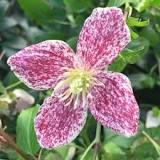 Cut it back hard (by 2/3) after flowering. Clematis cirrhosa is winter flowering and needs full sun. “Freckles” produces a lovely red streaked flower. You could hide it among your summer flowering clematis. It needs moisture and feeding, but no need to prune.
Cut it back hard (by 2/3) after flowering. Clematis cirrhosa is winter flowering and needs full sun. “Freckles” produces a lovely red streaked flower. You could hide it among your summer flowering clematis. It needs moisture and feeding, but no need to prune.
Peter recommended the use of mycorrhizal fungus to help roots develop. Remember the fungus needs to be in contact with the roots – there is no point trying to water it in.
Lastly, he recommended the use of a 1:1 mixture of Jack’s Magic compost and John Innes No 3.
The March talk was on Bedding Plants, by David Usher
David spent much of his earlier career working for Bath Parks Department before being appointed Head Gardener at the famous Hestercombe Garden in Somerset. At Hestercombe the Victorian Terrace was replanted using colours recommended by Gertrude Jekyll.
He suggested that a great use of bedding plants is to create seasonal change around more permanent plants, and recommended using plug plants for good results. David emphasised the importance of pinching out the growing tip of young plants to ensure well shaped plants. He also recommended planting media such as Sutton’s Sow and Grow Pellets, which are particularly good for cuttings.
Good air circulation is essential in the greenhouse, so don’t shut the door unless the weather is particularly bad.
David then showed examples of useful bedding plants and the growing conditions they like.
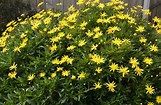
Euryops pectinatus – one of the plants recommended by David
Members were treated to an enjoyable and informative talk by Helen Roberts from the Met Office in Exeter. I asked her if she would be kind enough to send a few slides and she sent them all! A few are shown below.





